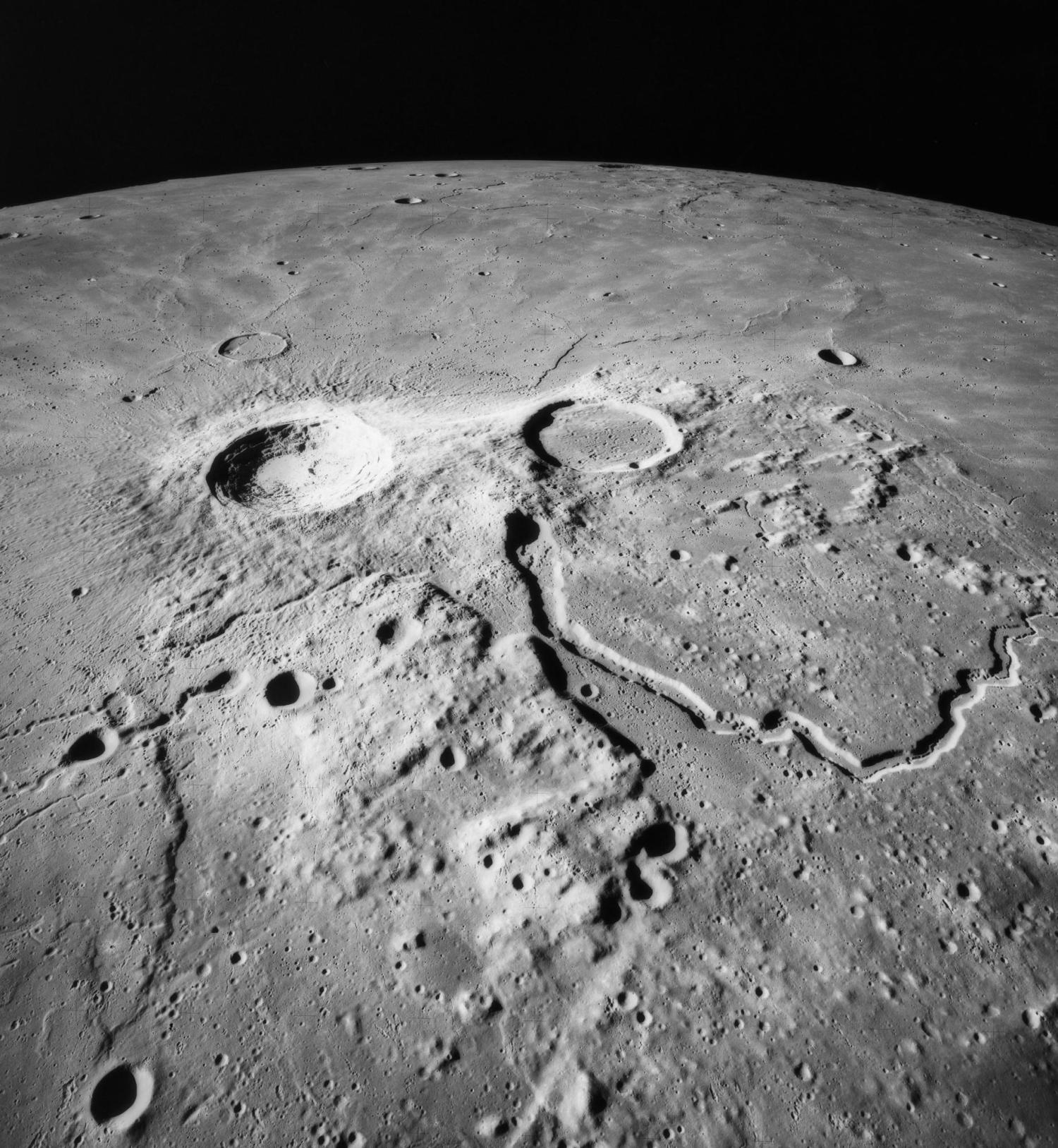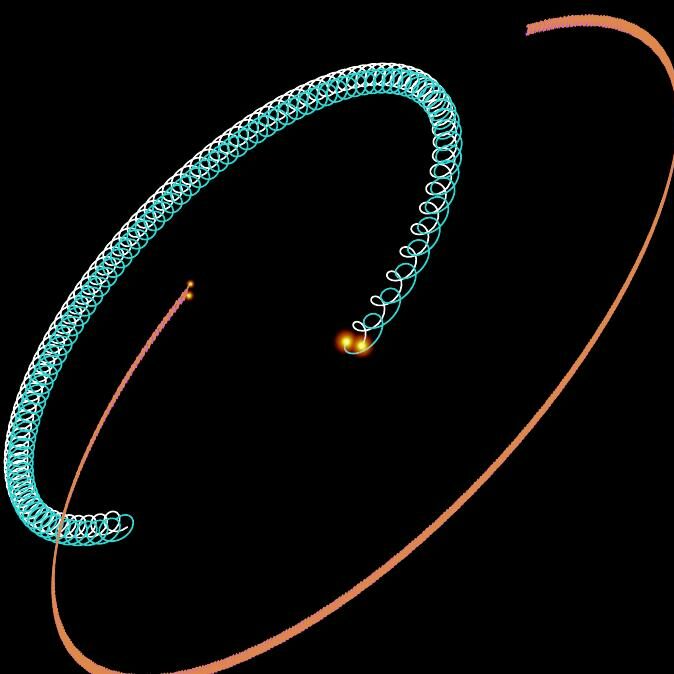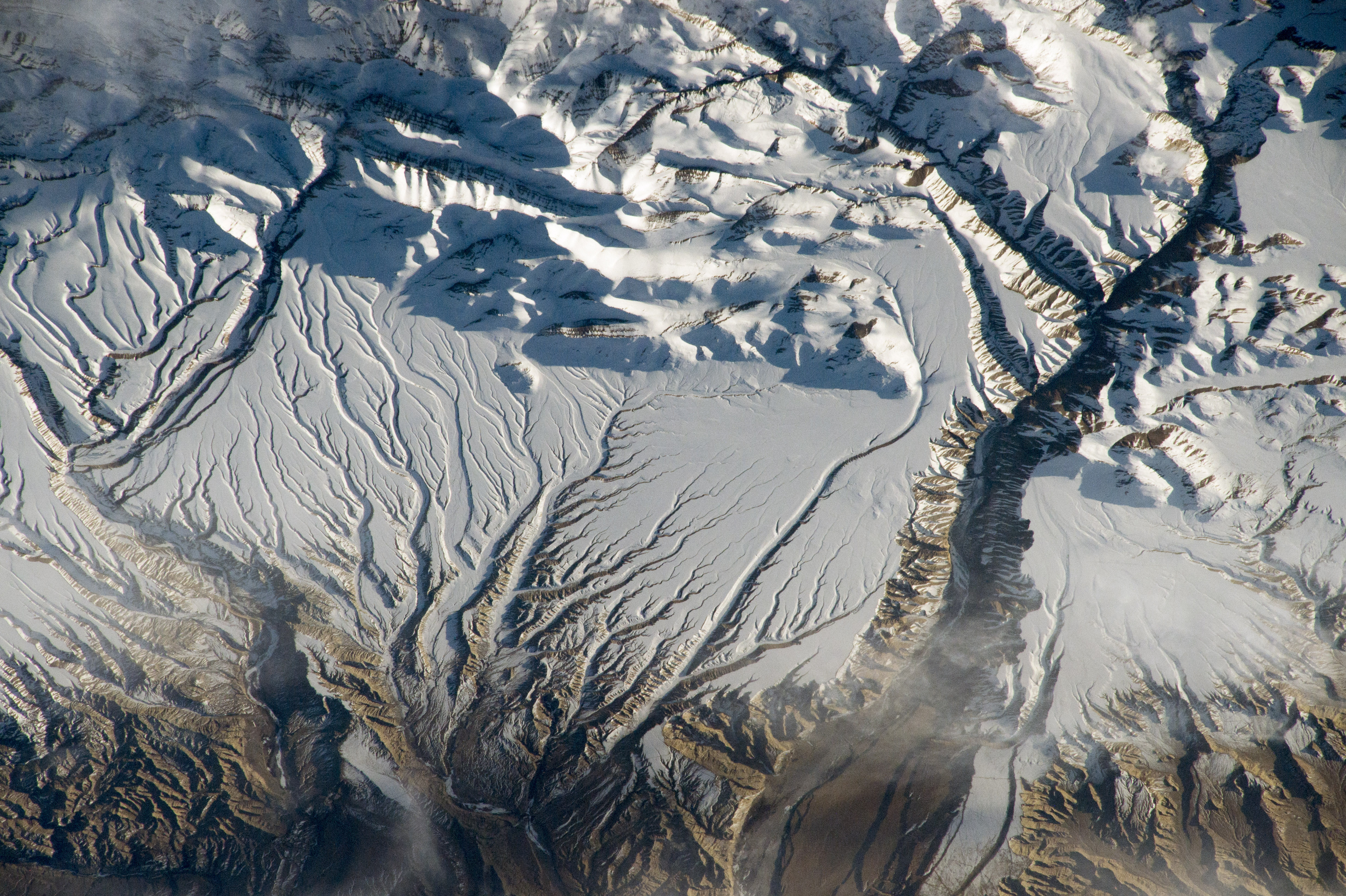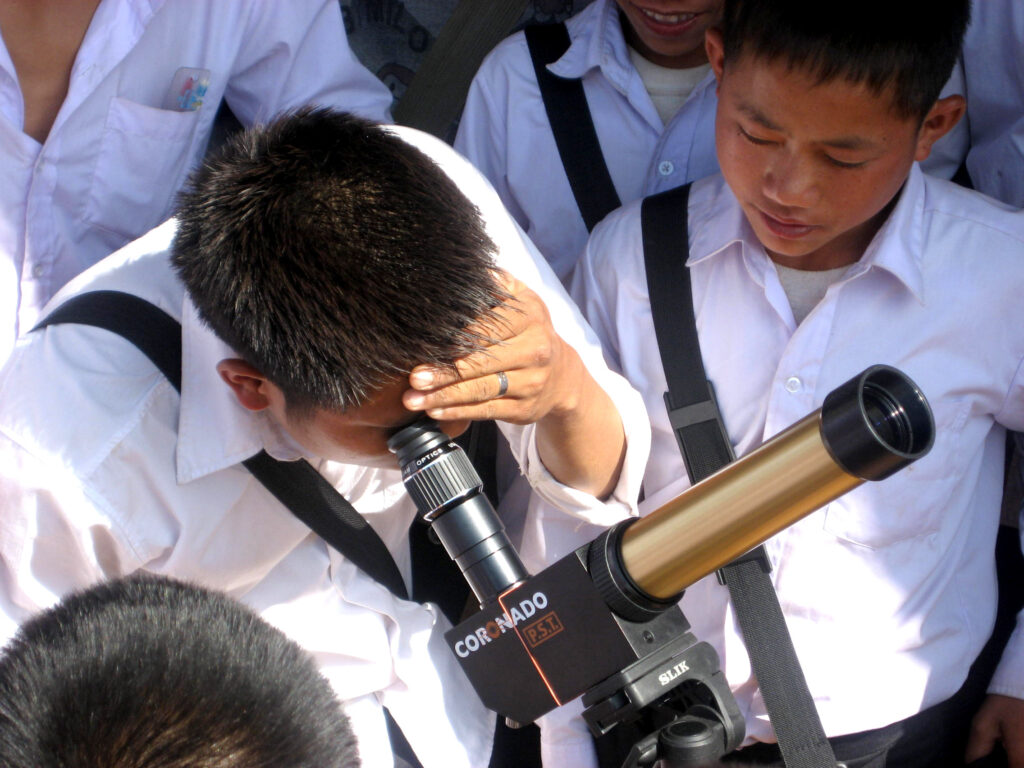With a groundbreaking technique, astronomers have used a galaxy as a gravitational lens to backlight two hydrogen clouds, peering back 11 billion light-years at our early universe. Plus, volcano water on the Moon, a quadruple star system, and this week’s What’s Up takes a careful look at the Sun.
Podcast
Show Notes
How to drink lunar volcano water
- CU Boulder press release
- “Polar Ice Accumulation from Volcanically Induced Transient Atmospheres on the Moon,” Andrew X. Wilcoski, Paul O. Hayne, and Margaret E. Landis, 2022 May 3, The Planetary Science Journal
Four stars pushed toward one explosion by evolution
- University of Canterbury press release
- “A spectroscopic quadruple as a possible progenitor of sub-Chandrasekhar type Ia supernovae,” Thibault Merle et al., 2022 May 12, Nature Astronomy
Using ant trails to help measure snow depth from space
- Frontiers press release
- “Deriving Snow Depth From ICESat-2 Lidar Multiple Scattering Measurements,” Yongxiang Hu et al., 2022 April 8, Frontiers in Remote Sensing
Galaxy used as ‘cosmic telescope’ to peer back in time
- Keck Observatory press release
- NC State University press release
- “Resolving the H I in damped Lyman α systems that power star formation,” Rongmon Bordoloi et al., 2022 May 18, Nature
Hubble spies string of stars forming regions
- NASA Goddard image release
Hubble reveals layered gas in galaxy
- NASA Goddard image release
What’s Up: The Sun and the Sombrero
- Pinhole Sun Viewer (Sonoma State University)
- VIDEO: How to SAFELY view an Eclipse and Find Sunspots (More Than the Sun)
- VIDEO: Erik makes a pinhole solar viewer
- Virgo the Maiden in northern spring skies (EarthSky)
Transcript
Today’s show is gonna be about stars, from a quadruple star system to our very own Sun.
And Erik will even show you how to safely view our Sun… if you want to leave the quiet of your monitor fort.
Which I do!
Plus, past volcanos on the Moon may lead to future water for astronauts.
Ants trails may lead to better snow depth measurements taken from space.
And we’ll look at how scientists are using gravitational lenses to look back in time.
All of this and more, right here on the Daily Space.
I am your host Dr. Pamela Gay.
And I am your host Erik Madaus.
And we’re here to put science in your brain.

Let’s kick off this show looking way back in the past to the early days of the Moon when volcanoes erupted with geologic frequency. Those volcanoes covered the surface in what we now see as dark maria, mostly smooth plains of basalt. But it’s possible that those eruptions also left a huge boon for future astronauts – sheets of ice under the lunar poles that could be hundreds of meters thick.
A new study in The Planetary Science Journal presents the results of complex computer simulations that attempted to recreate conditions on the Moon about two to four billion years ago. Scientists found that tens of thousands of volcanoes gave off massive amounts of water vapor, and then that vapor settled onto the surface as ice. The team estimates that almost half of the water from the volcanic eruptions condensed, which is an impressive amount. Had humans been alive at the time, they might have seen a frosty Moon with actual polar ice caps. Lead author Andrew Wilcoski notes: The atmospheres escaped over about 1,000 years, so there was plenty of time for ice to form.
The ice then eventually accumulated at the poles and ended up covered in a thick layer of regolith. Co-author Paul Hayne notes: It’s possible that 5 or 10 meters below the surface, you have big sheets of ice.
All the more reason for more exploration of the Moon because, if there is accessible water ice there, we can more easily plan for a lunar base with drinking water available and the components for rocket fuel on hand. If having a lunar base is your sort of wish, of course.
The Moon keeps turning out to be more complex and, frankly, interesting every day.
Speaking of complex, there are times when the press releases we receive miss the true wildness of what our universe is throwing at astronomers to try and figure out.

During recent observations of the system HD 74438, astronomers realized they weren’t looking at one star or even two stars, but they were looking at four stars — four fairly young, not very massive stars that are twinned together in an evolving dance. Still located in the open cluster in which they formed, these stars currently aren’t all that different from our Sun. Two of them are a bit bigger and shine a bit hotter. And two are a bit smaller and cooler. Looked at today, this is just a neat system that has two tight binary systems that are orbiting one another.
What is just a neat system today, however, may one day become a system that experiences all the wildest forms of stellar evolution as it potentially works its way toward an eventual explosion.
Multi-star systems like this are constantly changing. The complex gravitational tugs pull the stars into stretched-out orbits and can even drive them into collision courses over time. Mass will get pulled to and fro, and the four normal stars we see today will lose mass, pass mass, and maybe even combine masses.
In a new paper in the journal Nature, researchers led by Thibault Merle use computer models to work through all the different possibilities. It isn’t possible to say exactly what will happen; there is no single solution for how these kinds of stars will orbit in the long term, and when you start factoring in the changing sizes of their lives, and things like mass loss, there are a lot of possibilities.
With computers, it is possible to see what is most likely. In about half the models, the stars remain four separate stars, but in the other half of the models, they get close enough that two or three of the stars will spiral together, heat one another up, and become surrounded by a shared stellar atmosphere.
This is a far, far future possibility – it’s stuff that will occur when some to all of the stars are compact white dwarfs – and this kind of merger will essentially take multiple elder stars and give them new life as a single younger star.
And in those situations where the system ends up with one white dwarf orbiting around that new, combined mass, star – in that one possible kind of future, which can be reached in more than one way – the last white dwarf can do as white dwarfs sometimes do and gravitationally steal material from that one companion star that used to be three stars. And if it steals enough mass and hits a critical mass, it will explode as a type 1a supernova.
I feel pretty comfortable saying this research team found perhaps the most convoluted way to produce a supernova.
To summarize: researchers found four stars orbiting together, and if they evolve just right, three of those stars will die, merge together and be reborn, and then feed their atmosphere to a fourth star, and that mass will make that fourth star explode.
Go science? One of the most amazing things about our universe is that we actually have the capacity to understand it.
We often have stories where space technology is applied to something from Earth. In rare cases like this next story, the reverse is true.

Tracking ice thickness from space is important because as climate change gets worse, more and more ice will be lost, adding to our rising ocean levels. It’s hard to take these measurements currently because the method requires combining two different data sources: LIDAR and microwaves.
Now, new research presented in the journal Frontiers in Remote Sensing proposes a way to get this done using just LIDAR, and it involves ants, indirectly.
There is existing data on how far an ant travels in its underground nest, and researchers at NASA Langley modified that data to estimate how long photons travel in snowbanks before returning to a detector. This distance is twice the snowbank’s actual depth. This data is used for climate change and also water resource management. Basically, they can predict how much water a community can expect to get from a snowbank later. This data will also be used to predict snowfall decline as this is harder than predicting changes in rainfall.
According to one of the team members, Yongxiang Hu: I studied [the] properties of clouds and learned light bounces among cloud particles randomly, similar to the ants’ movement inside its colony. So, I thought that the ants theory might apply to snow too since snow comes from clouds.
This technique has so far only been used on the ICESat-2 satellite, launched in 2018 on the last Delta 2 rocket. Researchers hope to use this technique in new satellites developed for the purpose, which are being designed right now.
Coming up next, we’ll see how scientists are using gravitational lensing to look back into the deep past of our universe.

One of the recurring themes around here is that “astronomers desperate for data use gravity as a lens to magnify the early universe.” We’ve talked a bunch about how folks have looked toward galaxy clusters, hoping to find the distorted light of some of our universe’s first galaxies getting magnified by the cluster’s mass so that we can see what we normally can’t be seen. This technique has been remarkably successful, and researchers have been able to start research on topics we thought would require using the JWST.
Now, in a new paper in Nature, researchers led by Rongmon Bordoloi find that background galaxies and stars aren’t the only things they can see. Using the background galaxy as a spotlight, they are able to study a cloud of gas as it is magnified by a galaxy cluster. This is the first time the actual structure of this kind of intergalactic cloud has been able to be seen. While they only captured two systems in this study, their work opens the door to entirely new areas of research.

This team is finding that the clouds – the kinds of clouds that can form galaxies – are up to more than a billion solar masses in size and can vary in density by a factor of ten over just a ten light-years distance.
This is literally the stuff that galaxies are made of.
While the galaxy used to light up those clouds wasn’t the most photogenic thing, the Hubble Space Telescope is making up for it with a pair of pretty image releases.
In this first picture, we are looking at just part of an amazing image of the Hickson Compact Group 31 — a small system of tightly bound together galaxies. In this image, we see two galaxies appearing as one mashup of gas and dust decorated with bursts of star formation. To their right is another lineup of stars and gas that are almost separate, save for a bridge of star formation. These three galaxies will eventually merge into one system, but that will be far, far in the future.
Oh, and that pretty spiral? That’s just an unrelated background system.
You can see this image and all the images in this episode on our website DailySpace.org.
As much as many of us tend to focus on beautiful spiral galaxies, the reality is that distorted systems and giant blobs are out there being awesome in their own right and deserve our attention.

In this second Hubble release, we see the giant elliptical galaxy NGC 474. It is 2.5 times wider than our own galaxy and is the culmination of multiple systems merging together. Researchers think the shell-like structures in this image are leftover structures from a merger that sent ripples through the system — sort of like how a pebble sends ripples through water.
These kinds of delicate structures are generally only found in isolated systems. In the crowded regions of galaxy clusters, shells don’t survive. This system’s ghostly beauty is really a reflection of galaxies merging to become one and then carrying on in lonely isolation.
From distant galaxies, we now turn toward our solar system’s own central star as Erik shows us how to safely observe the Sun.
What’s Up
I’m going to tell you about something you can see in the sky this coming week, but first, I’m gonna hand things off to pre-recorded Erik who will explain how to make a pinhole solar viewer so you can safely view the Sun without spending seven hundred dollars on an h-alpha telescope.
For those of you listening to us in podcast form, the video will be available on our website, DailySpace.org. Thanks, Past Erik, and Ally who is gonna have to edit all this together.

Before we get too far away from solar observing, two notes. First, the solar maximum is the top of the eleven-year solar cycle, when the Sun is the most active with sunspots and prominences. Hence all the notifications we are getting about solar flares of varying strengths.
Second, you can use your ordinary telescope to observe the Sun in more detail than looking at a paper plate. There are many designs of glass or film filters that go over the front of your telescope. A solar filter that goes anywhere else is not safe. A good brand for the solar film is Baader. You can either get sheets of material or a premade filter that you fit around different sizes of telescope. A premade filter is more expensive than one you make yourself, but still massively cheaper than getting a dedicated solar telescope. Also, you can still use your regular telescope for nighttime observing without the filter attached.
The advantage of a dedicated h-alpha scope is you can see details on the surface of the Sun and some features shooting off of it because these features emit light in one specific wavelength, and you can filter out all the rest.
On to what you can see in the night sky this week. We talked about the galaxy M87 a little bit last week in reference to the news about the picture of Sgr A* in our own galaxy, but there is so much more to see in the constellation Virgo.

M87 is part of a large cluster of galaxies called the Virgo Cluster. It contains thousands of galaxies and a handful of ones that you can see easily through a telescope. These include M49, 58, 59, 60, 84, 86, and 89. All seven of these galaxies are between magnitude 8 and 9, easily visible in a small telescope.
Another object we’ve mentioned recently is the Sombrero Galaxy; it’s in Virgo as well. It is another magnitude 8-ish galaxy. It is edge-on, making for an interesting astrophotography composition if you have enough focal length to fill the frame.
So remember, go outside and look up, but if you’re looking at the Sun, make sure you do it safely.
This has been the Daily Space.
You can find more information on all our stories, including images, at DailySpace.org. As always, we’re here thanks to the donations of people like you. If you like our content, please consider joining our Patreon at Patreon.com/CosmoQuestX.
Credits
Written by Pamela Gay, Beth Johnson, Erik Madaus, and Gordon Dewis
Hosted by Pamela Gay, Beth Johnson, and Erik Madaus
Audio and Video Editing by Ally Pelphrey
Content Editing by Beth Johnson
Intro and Outro music by Kevin MacLeod, https://incompetech.com/music/


 We record most shows live, on Twitch. Follow us today to get alerts when we go live.
We record most shows live, on Twitch. Follow us today to get alerts when we go live.